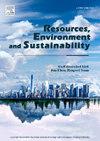树种多样性对土壤侵蚀抗性的尺度依赖效应
IF 12.4
Q1 ENVIRONMENTAL SCIENCES
引用次数: 0
摘要
在全球范围内,植被建设是控制土壤侵蚀的重要途径。然而,树种多样性对土壤可蚀性的影响在空间尺度上的认识仍然不完整。本研究采用通用土壤流失方程模型量化土壤可蚀性,并将其与全球森林生物多样性倡议数据库中获得的树种多样性数据进行比对。我们的研究结果表明,全球土壤可蚀性随着树种多样性的增加而降低,尽管这种关系在生物群系和生态区之间有所不同。在11个生物群系中,有6个群落和54.90%的生态区,土壤可蚀性随树种多样性的增加而降低。综合分析显示,生产力、NDVI和基础面积的增加介导了两组可蚀性的降低。在树木多样性与土壤可蚀性呈负相关的生态区,与树木多样性与土壤可蚀性呈正相关的生态区相比,树木多样性与土壤可蚀性呈负相关的生态区在最干旱月份和季度降水较少、降水季节性较强、粉砂含量较低、海拔较高。在以粘土含量为特征的生态区域中18.3%,含粉量<;随着树种多样性的增加,土壤可蚀性降低的比例分别为40%和79.55%。这些发现强调了生物多样性-土壤可蚀性关系固有的空间变异性和机制复杂性,强调了有针对性的土壤修复策略的必要性。本文章由计算机程序翻译,如有差异,请以英文原文为准。

Scale-dependent effects of tree species diversity on soil erosion resistance
Globally, vegetation establishment is an important approach for controlling soil erosion, which induces land degradation. However, the understanding of the effects of tree species diversity on soil erodibility across spatial scales remains incomplete. This study employed the Universal Soil Loss Equation model to quantify soil erodibility and aligned it with tree species diversity data obtained from the Global Forest Biodiversity Initiative database. Our findings revealed a global decrease in soil erodibility with increases in tree species diversity, though this relationship varies among biomes and ecoregions. Specifically, soil erodibility decreased with increasing tree species diversity in 6 of the 11 biomes and 54.90% of the ecoregions analyzed. Comprehensive analyses revealed that increased productivity, NDVI, and basal area mediated this reduction in erodibility across both groups. In ecoregions where tree species diversity was negatively correlated with soil erodibility, lower precipitation during the driest month and quarter, higher precipitation seasonality, lower silt content, and higher elevation were observed compared with those of the ecoregions with positive correlations between tree species diversity and soil erodibility. Among ecoregions characterized by clay content > 18.3% and silt content < 40%, 79.55% exhibited a reduction in soil erodibility as tree species diversity increased. These findings highlight the inherent spatial variability and mechanistic complexity of biodiversity-soil erodibility relationships, underscoring the need for targeted, soil-specific restoration strategies.
求助全文
通过发布文献求助,成功后即可免费获取论文全文。
去求助
来源期刊

Resources Environment and Sustainability
Environmental Science-Environmental Science (miscellaneous)
CiteScore
15.10
自引率
0.00%
发文量
41
审稿时长
33 days
 求助内容:
求助内容: 应助结果提醒方式:
应助结果提醒方式:


